商务英语被动语态翻译
- 格式:ppt
- 大小:2.22 MB
- 文档页数:15
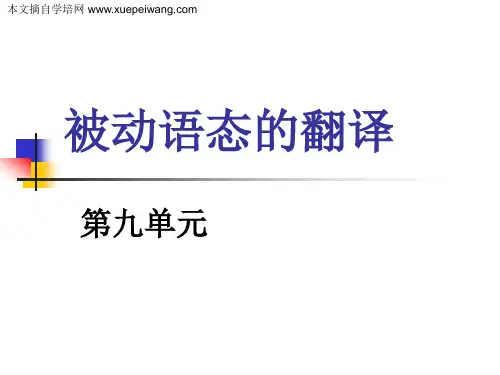
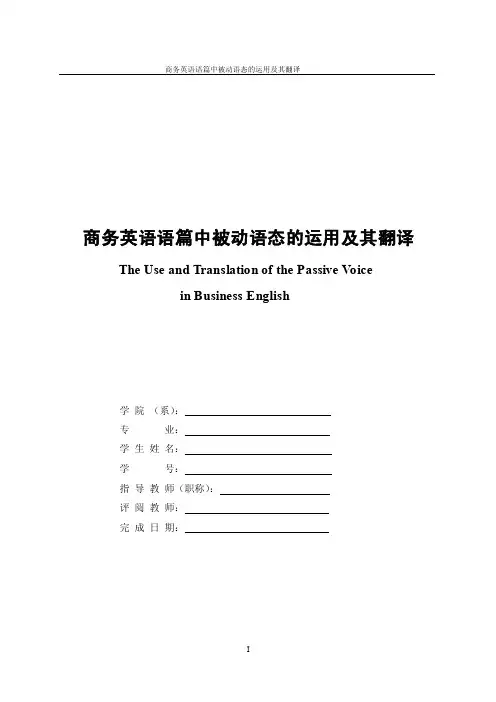
商务英语语篇中被动语态的运用及其翻译The Use and Translation of the Passive Voicein Business English学院(系):专业:学生姓名:学号:指导教师(职称):评阅教师:完成日期:I商务英语语篇中被动语态的运用及其翻译[摘要]被动语态是语言学中较为常见的语法现象。
较汉语而言,英文中使用得更为广泛,尤其是在商务英语这一实用性语体中更是有着举足轻重的地位。
本文共分四章对此课题进行研究,首先对英汉语篇中被动语态做对比分析;接着进一步探究了商务英语中被动语态的分类、功能及运用,商务英语中被动语态的大量使用实现了正式、公正、礼貌、委婉等语用功能,是合作原则与礼貌原则的体现;然后具体介绍了商务英语中被动语态的翻译,由于汉语中较少使用被动语态,因此翻译上应注重功能对等,在措辞上遵循汉语表达的同等语用功能;最后做出总结。
[关键词]商务英语;被动语态;运用;翻译IIThe Use and Translation of the Passive Voicein Business EnglishEnglish MajorAbstract: The passive voice is a common grammatical phenomenon in linguistics. Compared with the Chinese, it is used more widely in English, and it also has a pivotal position in the practical Business English language. This paper is divided into four chapters to discuss this subject. At first,we do comparative analysis of the passive voice in Chinese and English; And then further explore the classification, function and use of passive voice in English. The extensive use of passive voice has achieved formal, impartial, courteous, tactful and other pragmatic functions, which also shows the principle of cooperation and courtesy; then it specifically introduces the translation of passive voice in English. Because the passive voice is less used in Chinese, we should focus on the functional equivalence of translation that is, trying to make the Chinese wording have the same pragmatic function; At last we have a summary.Key words: Business English; passive voice; use; translation strategiesIIIContentsIntroduction (V)Chapter 1 The Comparison of Passive V oice in English and Chinese (2)1.1 The forms of passive voice (2)1.1.1 The form of passive voice in English (2)1.1.2 The form of passive voice in Chinese (2)1.2 The features of passive voice (3)1.2.1 Format (3)1.2.2 The relationship of subject and object (5)1.2.3 The mobility (5)1.3 The factors of using passive voice (5)Chapter 2 Passive V oice in Business English (6)2.1 Classification (6)2.2 Pragmatic function (6)Chapter 3 The Translation Strategies of the Passive Voice in B usiness English (9)3.1 Using passive forms (10)3.2 Using active forms (10)Conclusion (12)References (14)Acknowledgements (XIX)IVIntroductionInternational business activities are increasing in today‟s economic globalization. The English used in the introduction of technology, foreign trade, investment, foreign contracting and labor service contracts, international finance, foreign insurance, overseas investment and other fields are all called Business English. Business communication is the bridge for people to explain views and achieve cooperation, which is inseparable from the speech activities. English as a universal language in the world plays an important role in business verbal communication. Business English is a branch of the English language system, which serves for the specific international business activities. It is based on English vocabulary, basic grammar and sentence structure, but it has a unique language phenomenon and content. From the stylistic features of Business English, we can easily find there are lots of passive sentences, which are not commonly used in Chinese, so we have encountered problems in the translation. It is necessary for us to have a comparison of the differences between English and Chinese. Exploring the use of passive voice in business English discourse and its translation is good for a translator to grasp the original style, make a rational wording and protect the speakers‟interests as well as manifest their courtesy and cooperation.VChapter 1 The Comparison of Passive V oice in English and Chinese1.1 The forms of passive voicePassive voice is a common grammatical phenomenon in English which is opposed to the active voice. It composed of different tense of “to be” followed by a verb‟s past participle form and the subject is the bearer of the action. Passive voice can avoid giving others the subjective feeling, so that the text is more objective and formal and the tone will be more tactful. “English passive voice has a variety of forms, and there are strict rules for the structure and syntax. While in Chinese only one word or phrase in the passive form can show the passive voice.”(何自然,1988:42) [1]1.1.1 The form of passive voice in EnglishA. The passive voiceThe passive voice is the most common form to manifest the English passive meaning, in general, it is composed of “be + past participle”or “get / become + past participle”.The passive voice composed of “g et / become + past participle” generally refers to the result of the action rather than the action itself.It often expresses the meaning that something is finally done, something takes place suddenly or someone has a chance encounter. It can also show the “gra dation” of the state, emphasis on action process. For example:[e.g. 1] History is made by the people.The more I hear, the more I get / become troubled.B. The active form expressing the passive meaningThere are some verbs with active form in English which actually are expression of passive meaning. For example,[e.g. 2] The man is drowning = The man is being drowned.1.1.2 The form of passive voice in ChineseUnlike English passive sentence,the Chinese passive sentence doesn‟t change the form. The difference between passive sentence and active sentence lies in the “mark words of the form”. If you don‟t take the semantic level into account, there is no different sign between the form of passive sentences and the general structure of the active sentences. Therefore, the Chinese passive sentence can be also divided into two categories: passive sentence with theVInegative mark and the active form expressing passive meaning. This presentation will help us to compare it in English and Chinese. Chinese passive sentence is verb-predicate sentence and its adverbial is preposition phrase composed of “被”. The subject is the bearer of the verb, and the object is the executer. For example, “敌人被我们消灭了。
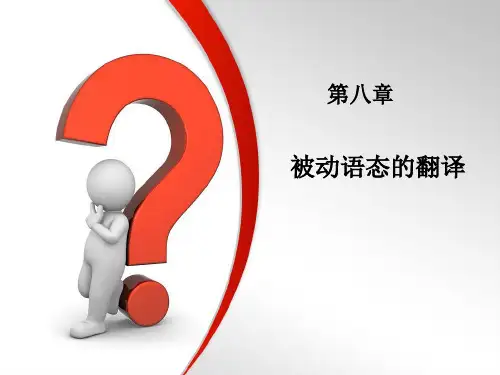

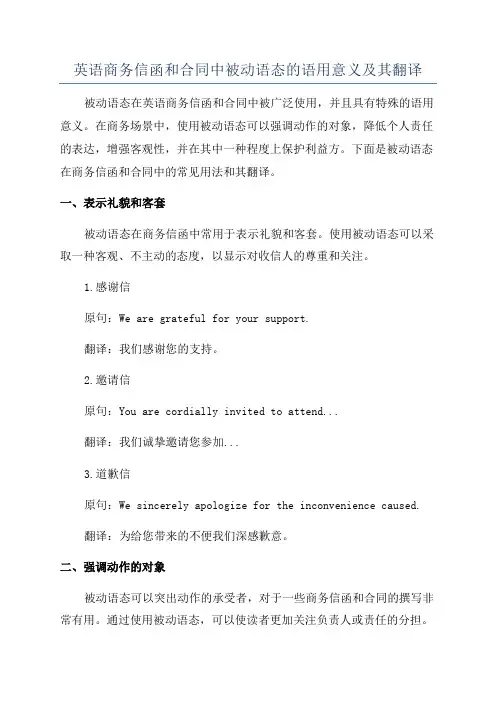
英语商务信函和合同中被动语态的语用意义及其翻译被动语态在英语商务信函和合同中被广泛使用,并且具有特殊的语用意义。
在商务场景中,使用被动语态可以强调动作的对象,降低个人责任的表达,增强客观性,并在其中一种程度上保护利益方。
下面是被动语态在商务信函和合同中的常见用法和其翻译。
一、表示礼貌和客套被动语态在商务信函中常用于表示礼貌和客套。
使用被动语态可以采取一种客观、不主动的态度,以显示对收信人的尊重和关注。
1.感谢信原句:We are grateful for your support.翻译:我们感谢您的支持。
2.邀请信原句:You are cordially invited to attend...翻译:我们诚挚邀请您参加...3.道歉信原句:We sincerely apologize for the inconvenience caused.翻译:为给您带来的不便我们深感歉意。
二、强调动作的对象被动语态可以突出动作的承受者,对于一些商务信函和合同的撰写非常有用。
通过使用被动语态,可以使读者更加关注负责人或责任的分担。
1.报告信原句:The plan has been approved by the board of directors.翻译:该计划已得到董事会的批准。
2.雇佣信原句:You have been hired for the position.翻译:您已被聘为该职位。
3.补偿协议翻译:公司将支付这些费用。
三、降低个人责任被动语态还可用于商务合同中,以降低个人责任的表达,减少争议和风险。
1.合同条款原句:Payments must be made within 30 days.翻译:付款必须在30天内完成。
2.不可抗力条款原句:The party shall not be liable for any delay or failure caused by force majeure.翻译:一方因不可抗力造成的任何延迟或失误不应承担责任。
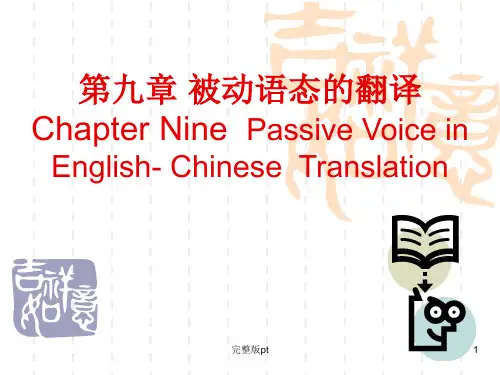
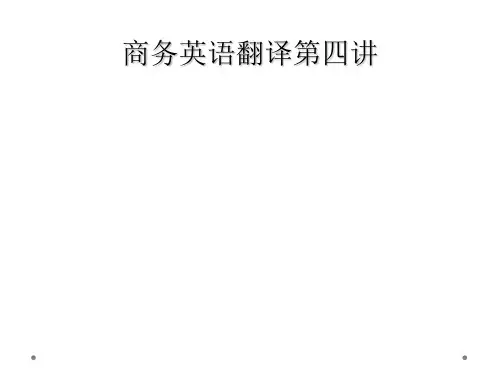
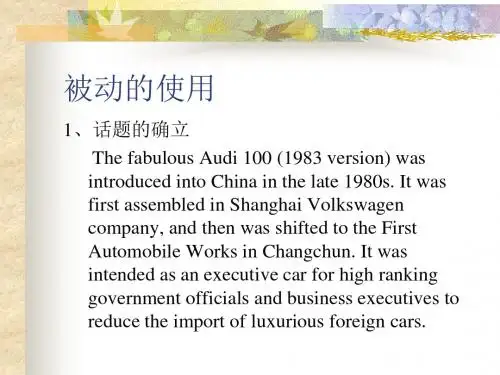


商务英文合同中被动语态的功能分析及其翻译摘要:商务英文合同作为一种独特的文本形式,在国际贸易交往中能够确定交易各方权利、责任和利益的具有法律效力的文本形式。
因此要求其文本语言必须严谨、客观、公正,而被动语态在商务合同中的运用恰好能够体现商务合同的文本语言特点,传递主动语态无法表达的信息。
本文通过分析商务英文合同中被动语态的构成及语用功能的分析,为商务英语合同文本的翻译提供新思路。
关键词:商务英文;合同;被动语态【doi】10.19312/ki.61-1499/c.2016.04.098世界经济日趋一体化的进程使得全球经济活动更加频繁,现代经济活动对跨文化交际的国际商务合同的需求也越来越迫切。
商务合同作为商务活动中正式的文本,确定合同各方的权利、责任和义务,敦促合同各方严格按照合同进行交易,具有一定的法律效力,也对合同各方具有较强的约束作用。
商务交往中有关经济体在进行商务合作时,为了确定各自的权利和义务,在公证部门的监督下,共同签订的、正式的、必须共同遵守的协议条文。
合同的形式多种多样,而商务合同的书面形式有利于合同当事人发生纠纷时进行举证,也是当事人进行解释和推定的依据。
因此,在跨文化商务活动中,商务合同的重要性不言而喻。
而合同能否在不同文化、不同的语言环境中能否准确有效地翻译,决定着合同中各当事人的权利与义务的划分,影响到合同的履行、变更、终止及违约、仲裁等一连串的问题。
从专业化角度出发,被动语态属于英语当中比较常见的语态,其具有使用范围相对较广以及数量相对较多的特点,与汉语中的被动语态是无法比拟的,尤其在科技文体、商务文体、法律文体中应用非常广。
因商务合同主要是一种规定各方权利以及义务的专业性文书,在文字叙述方面要求客观公正以及措辞严谨,所以英文商务合同当中往往会广泛应用被动句,从而更好地体现合同在文体方面所具有的严谨性。
具体来说,英文商务合同在被动句应用上,主要包括包装条款、运输条款、保险条款、付款方式条款以及检验条款等。

句式练习4:全心全译被动语态1. In the present war allegedly for human rights, damages are made by computers, not by the weapon in a warrior’s hand.据说,在如今的战争中人权,损失是由电脑,而不是战士手中的武器控制的。
2. This extended cooperation must be intended not to limit but to enhance mobility of ideas and freedom of the scientists within the system.这种广泛的合作形式必须有助于而不是限制该系统内科学家进行思想交流和自由流动。
3. Most cars in the earliest days of the auto industry were what were called “assembled cars”.大多数汽车在汽车行业的早期被称为“组装汽车”。
4. The Mode T became the first car in which the vast majority of parts were built by either a single auto manufacturer, or by a supplier that was partially owned by our company.“T”型车成为有史以来第一种类型的汽车,其绝大部分零件都是由独家汽车制造商制造或由我们公司部分拥有的独家供应商提供的。
5. They are going to build an apartment house here next year. It is going to be built beside the Office Building.他们明年在这里要修建一座住宅楼,就修在办公楼旁边。